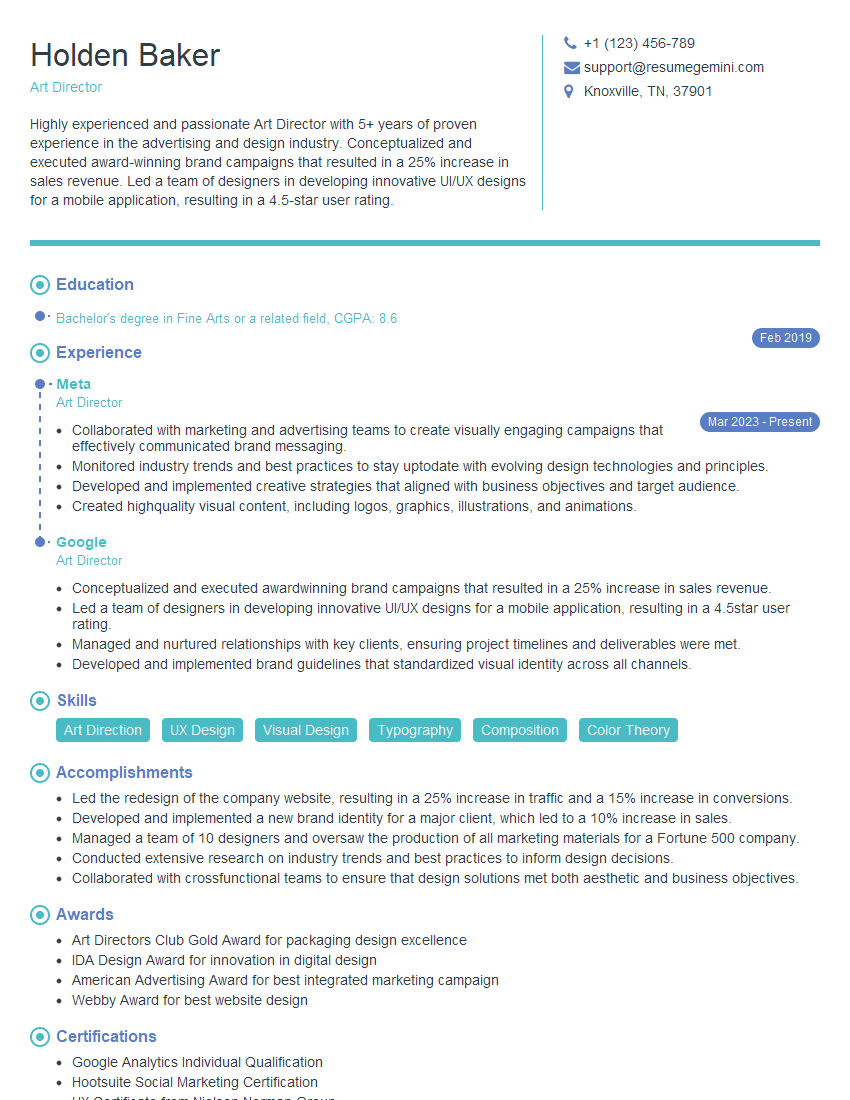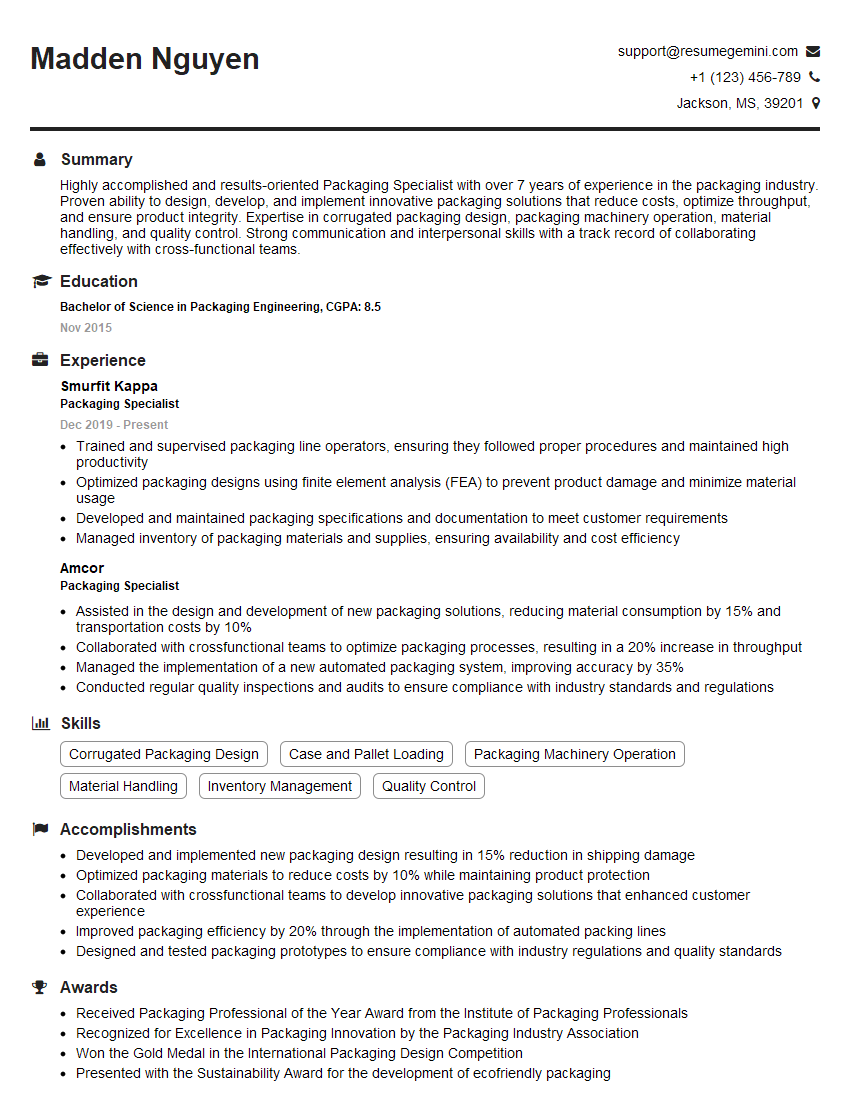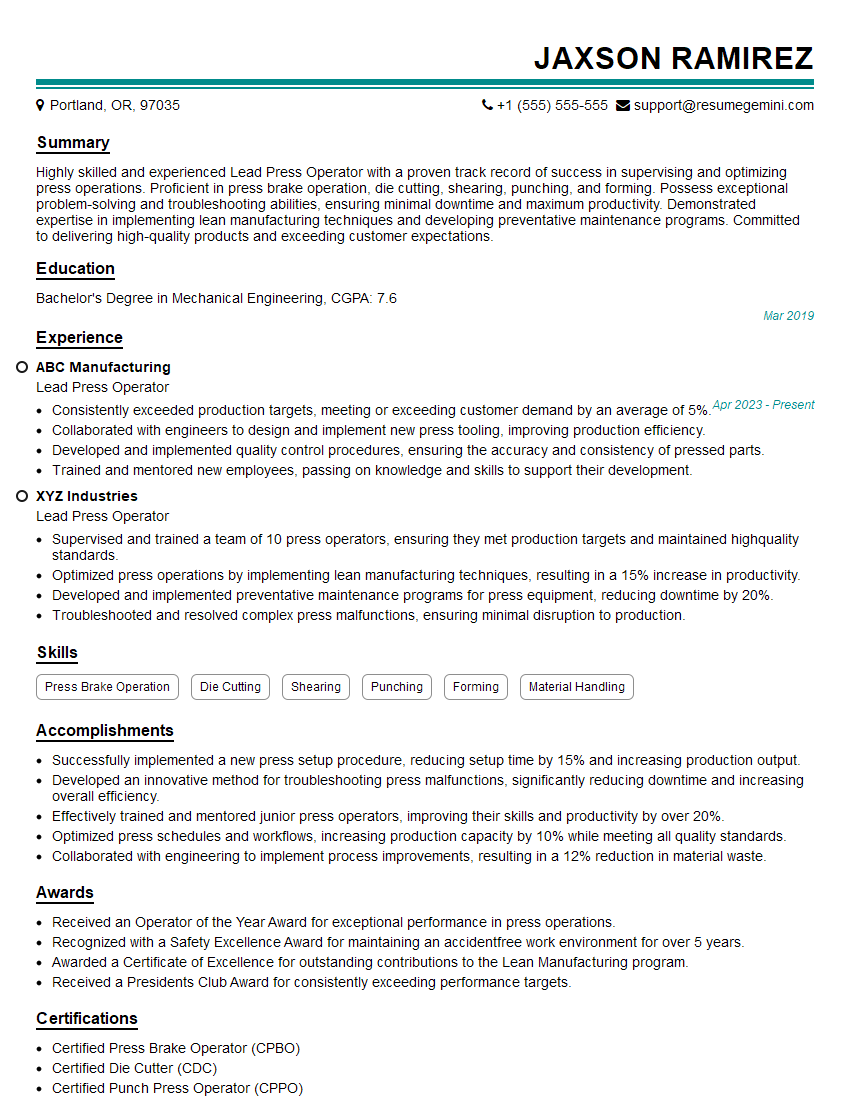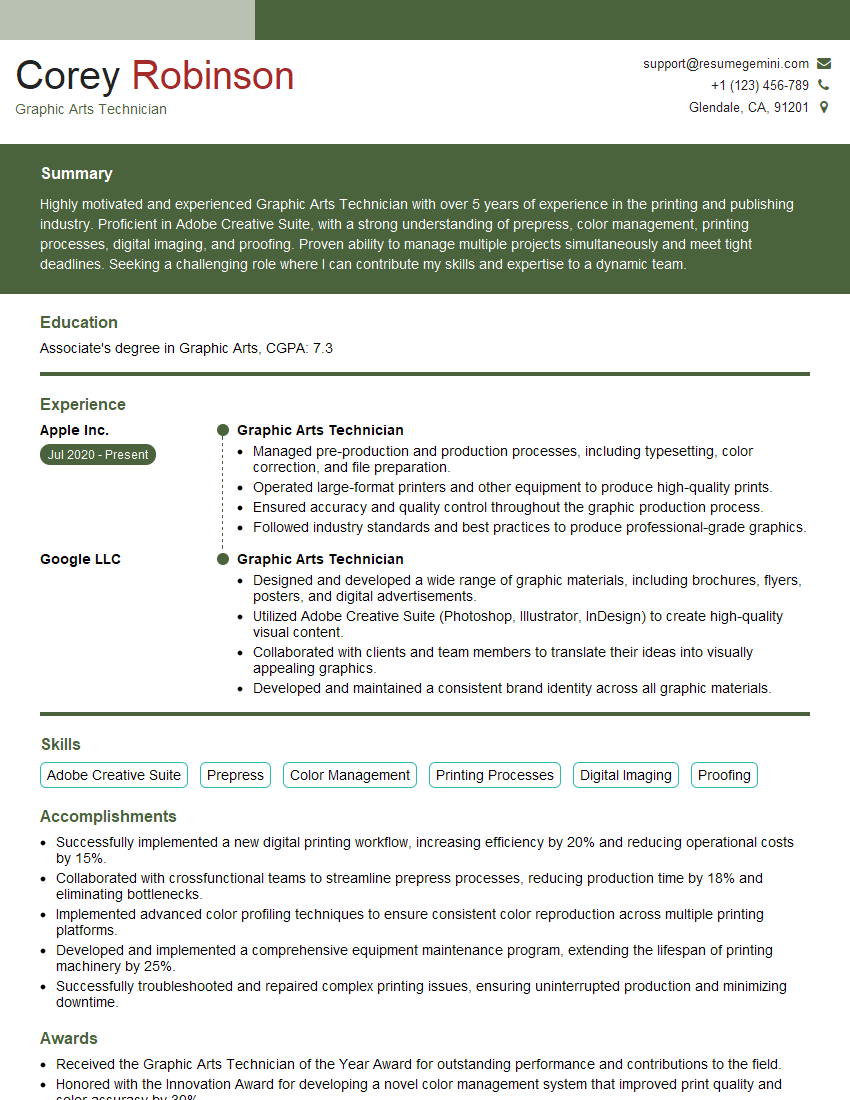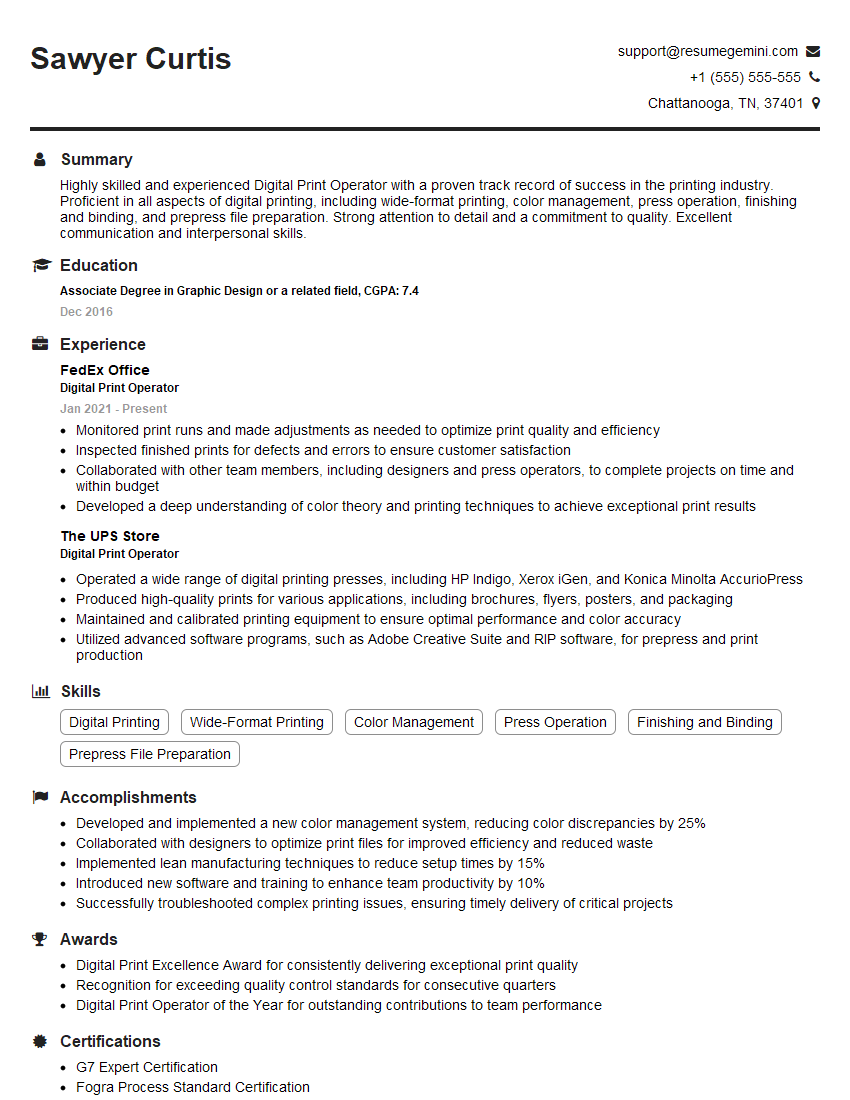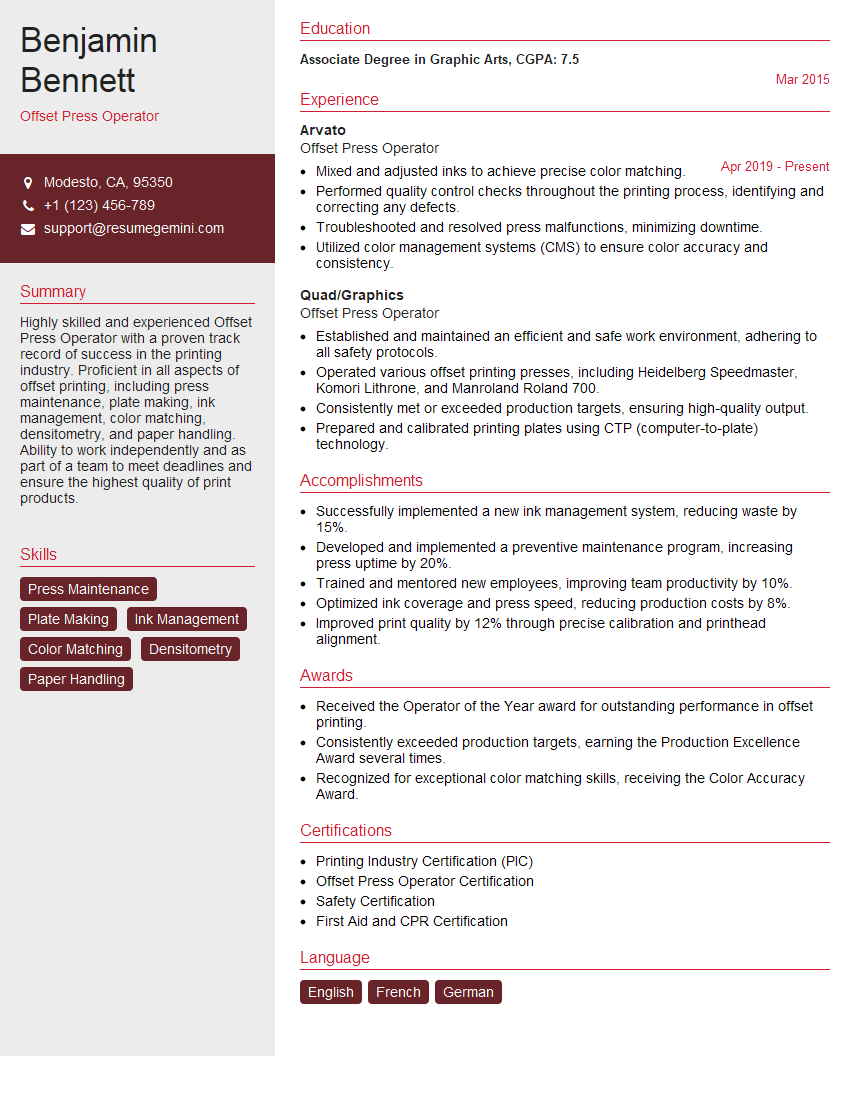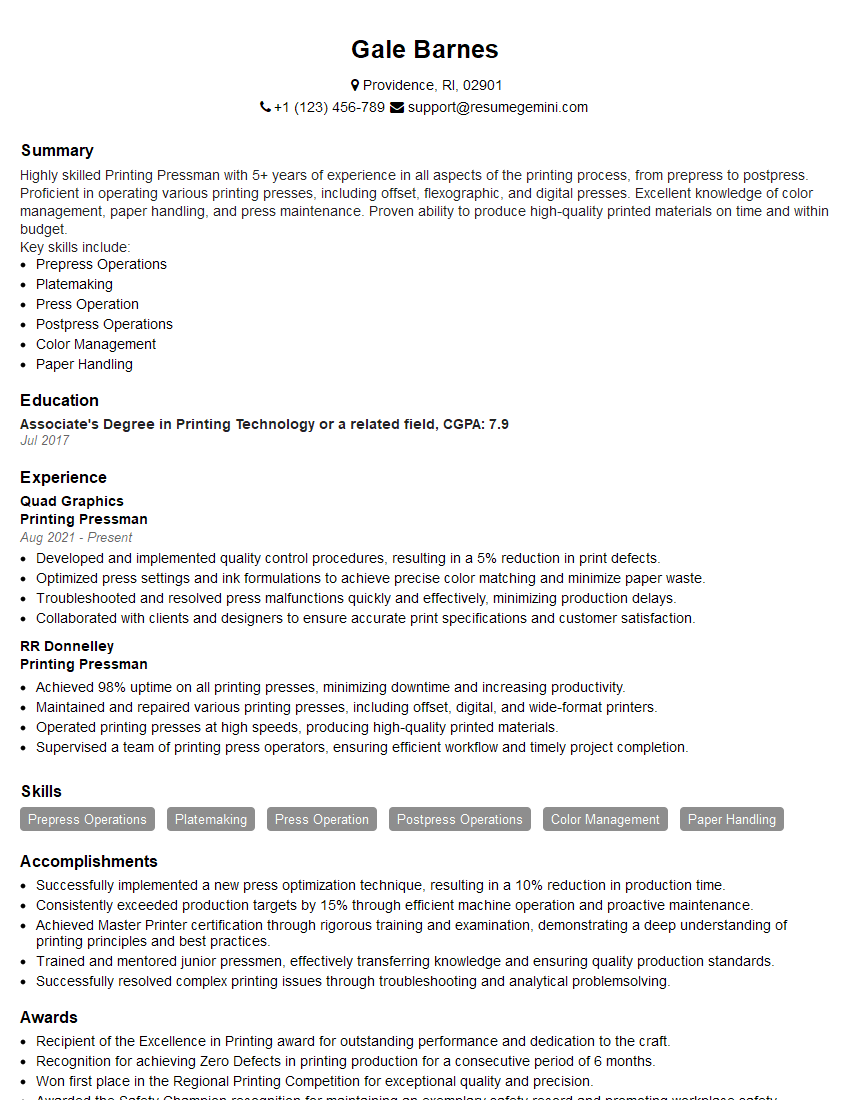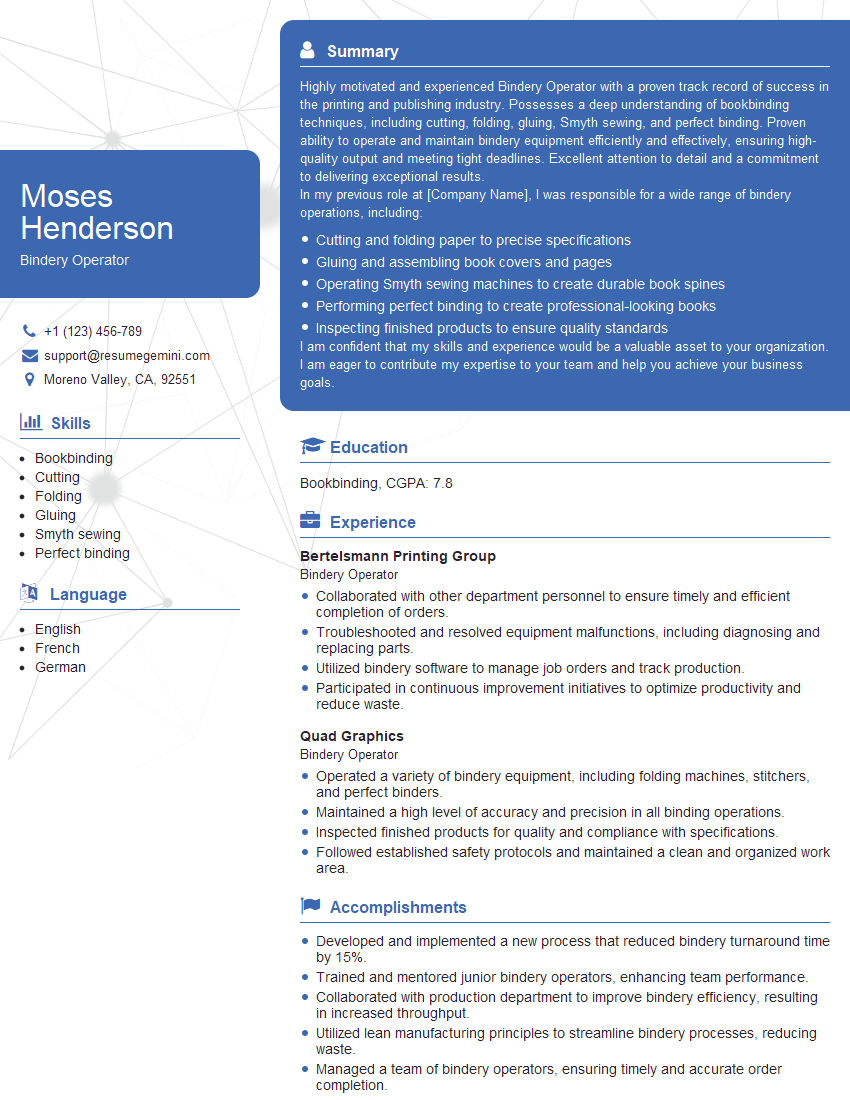Preparation is the key to success in any interview. In this post, we’ll explore crucial Book Bleed Control interview questions and equip you with strategies to craft impactful answers. Whether you’re a beginner or a pro, these tips will elevate your preparation.
Questions Asked in Book Bleed Control Interview
Q 1. What is bleed and why is it important in book printing?
Bleed, in book printing, refers to the extension of the printed image beyond the final trim size of the book. Imagine you’re printing a postcard – you want the image to go right to the edge, not leave a small white border. That’s bleed. It’s crucial because the printing process involves cutting the sheets after printing, and without bleed, you’d inevitably end up with unsightly white margins, even if your design intended to reach the edge. This is especially important for images that extend to the very edge of the page. Bleed ensures that even with slight inaccuracies in the cutting process, the final product appears as intended, without any gaps or unwanted white space.
Q 2. Explain the standard bleed allowance for different printing processes.
The standard bleed allowance is typically 3mm (or 1/8th of an inch) on all sides (top, bottom, left, and right). However, this can vary slightly depending on the printing process and the printer’s specific requirements. For example, some printers might require a slightly larger bleed for certain types of printing, such as large-format or perfect-bound books. It’s always best to confirm the exact bleed requirements with your specific printer before beginning the design process. Offset printing, which uses large printing plates, is usually more forgiving but still requires bleed. Digital printing, with its smaller-scale presses, may necessitate stricter adherence to the specified bleed. It’s a matter of anticipating and accommodating the margin of error in the mechanical finishing stages.
Q 3. How do you ensure accurate bleed marks are included in the prepress stage?
Ensuring accurate bleed marks is a critical part of prepress. We rely on software to automatically generate these. Most professional design software packages (InDesign, QuarkXPress, etc.) have built-in functions to add bleed marks. These marks aren’t visible in the final printed piece, but they serve as guides for the printer to know where to cut. It’s essential to verify the bleed settings before sending the files to the printer – a simple oversight can mean a costly reprint. A common checklist involves checking the document setup, confirming the bleed settings are accurate and consistent across all pages, and then generating a proof (preferably a hard proof) with the bleed marks visible to confirm everything is correctly positioned. Finally, a thorough review of the preflight report is recommended before final submission.
Q 4. Describe different methods for creating bleed in design software.
Creating bleed in design software is straightforward. In Adobe InDesign, for instance, you define your document’s dimensions including the bleed. Then you extend your images and backgrounds beyond the trim edge, making sure they are inside the bleed area but outside the final trim lines. File > Document Setup lets you set the bleed. In Illustrator, you’d extend your artwork beyond the artboard boundaries using similar techniques, and in QuarkXPress it’s again through document settings. The key is that these design programs manage the bleed area differently from the final printed area, ensuring the correct amount of bleed is included without altering your artwork within the final trim.
Q 5. What are the consequences of insufficient bleed?
Insufficient bleed leads to unsightly white borders around the edges of your book’s pages, especially noticeable in areas with full-bleed images. This significantly compromises the aesthetic appeal of your design, and makes the book look unprofessional. Imagine a stunning landscape photograph—a missing 3mm margin at the edge suddenly makes the picture incomplete and frustrates the designer’s careful work. Reprinting is costly and delays publication.
Q 6. What are the consequences of excessive bleed?
Excessive bleed, while less common, can also create problems. The printer might cut into your important design elements, resulting in the loss of crucial details or text. This might necessitate costly corrections and reprinting. It also wastes materials and can lead to discrepancies in the final print product. The careful balance is essential. A slightly oversized bleed won’t necessarily cause issues in most cases, but consistent adherence to the specified bleed values is the key to avoiding problems.
Q 7. How do you handle bleed issues during the proofing process?
Bleed issues are best addressed during the proofing stage. This is where careful visual inspection is combined with precise measurement. Compare the physical proof to the digital design file, meticulously checking for bleed discrepancies. A color proof is particularly helpful for identifying potential problems with color bleeds. If problems are detected, communication with the printer is essential to correct them before mass printing begins. In some cases, minor adjustments can be made in the final prepress checks, but major revisions might necessitate going back to the design stage, highlighting the crucial role of thorough proofreading.
Q 8. How does bleed affect different binding methods (e.g., perfect binding, saddle stitch)?
Bleed, the extension of artwork beyond the trim edge, impacts different binding methods differently. In perfect binding, where pages are glued together along the spine, bleed is crucial to ensure that the trimmed edge doesn’t show any unsightly white gaps. The bleed allowance needs to be sufficient to account for the slight variations in cutting. If bleed isn’t properly set, the finished book could have noticeable white edges along the spine.
With saddle stitch binding (where pages are folded and stapled), the effect of bleed is less critical, but still important. Bleed primarily affects the edges of the pages, ensuring the outer edges are fully colored. Incorrect bleed here can lead to uneven margins or white lines on the finished product, especially noticeable on the top and bottom edges.
Think of it like painting a wall: you need to paint slightly beyond the edges to ensure complete coverage after trimming. This is precisely what bleed is for in printing. The amount of bleed required varies slightly depending on the printer and the binding method, but a standard ⅛ inch (3mm) bleed is generally recommended.
Q 9. Explain the role of imposition in relation to bleed.
Imposition is the arrangement of pages before printing so that they print correctly and efficiently when folded and bound. Bleed is intimately linked to imposition because the bleed allowance must be accounted for in the arrangement. Imagine arranging puzzle pieces: each piece needs to be aligned with others, and you also must consider where the edges will fall to ensure there are no gaps.
In imposition software, you define the bleed area, and the software ensures that the bleed extends correctly across all pages. If the imposition is incorrect, then even if the bleed is correctly set up in the individual page design, the final printed sheets won’t align properly, leading to uneven bleed and potentially white margins in the finished product.
For instance, if you’re printing a 16-page booklet with a ⅛-inch bleed, the imposition software ensures that the ⅛-inch bleed on one page aligns seamlessly with the adjacent page after folding and binding. This prevents gaps in the final print.
Q 10. How do you verify correct bleed setup on different printing presses?
Verifying bleed setup varies slightly depending on the printing press, but the principle remains the same: you need to check the printed proof. On larger presses, we often use a test print called a ‘proof’ or ‘test sheet’. This will show the cut line and ensure the artwork extends to the intended bleed area. I always visually inspect the proof, paying close attention to the edges. A ruler and a sharp eye are essential here.
For digital presses, the process can be slightly faster. Many digital workflows allow for the creation of ‘soft proofs’ on screen, which offers a preview of the bleed. However, even with a soft proof, I always recommend ordering a physical proof for the most accurate representation of color and bleed. Measuring the bleed on the proof against the specifications is crucial.
Any discrepancy, even a fraction of a millimeter, can be problematic. I often use a measuring tool like a gauge to ensure the precise amount of bleed is present. If discrepancies appear, I liaise with the press operator to adjust the settings if necessary. This step is vital to avoid costly reprint runs.
Q 11. What are the common file format issues related to bleed?
File format issues are a common source of bleed problems. The most frequent issue is inadequate bleed in the design file itself. Designers may not extend their artwork sufficiently beyond the trim, leading to white space after cutting. Additionally, low-resolution images can appear pixelated when enlarged to fill the bleed area, compromising the print quality.
Another common problem is incorrect document setup. If the bleed is not set as part of the document’s dimensions in the software (e.g., InDesign, Illustrator), the printer might not be able to process it correctly. For example, if you’re working with an InDesign file, the bleed needs to be set within the document’s margins.
Finally, using outdated or unsupported file formats can cause trouble. Older formats may not properly handle color spaces or CMYK settings, impacting the print quality and potential bleed issues. Using the most up-to-date formats, and ideally, PDFs optimized for print is recommended.
Q 12. How do you communicate bleed requirements effectively to designers and clients?
Clear and consistent communication is key. I start by providing designers and clients with detailed specifications, including the exact bleed requirements (usually ⅛ inch or 3mm on all sides) and a visual guide showing how the bleed area should look. I also offer templates that already include the bleed allowances.
I often use visual aids like diagrams and example files to illustrate how the bleed should be implemented. I also emphasize the importance of bleed and what happens when it’s not set correctly. A simple analogy of painting slightly outside the lines can be helpful to clients who lack printing expertise.
Before the print job begins, I conduct a thorough review of the supplied files to ensure that the bleed requirements are met. I prefer direct communication rather than relying solely on email, to make sure there is no ambiguity or miscommunication.
Q 13. Describe your experience troubleshooting bleed problems.
I’ve encountered various bleed issues, from simple oversight in file preparation to more complex problems related to imposition or press settings. One memorable instance involved a client who submitted a file with insufficient bleed. This resulted in noticeable white lines on the final product after trimming. We immediately addressed the problem by re-submitting a corrected file, which incurred extra cost and delay.
Another time, a mismatch in the color profile between the design file and the press led to unexpected color shifts near the edges, affecting the bleed area. This highlighted the importance of strict color management throughout the entire printing process. I resolved this by working closely with the design team to ensure color consistency. The key to efficient troubleshooting is methodical investigation, identifying the root cause of the problem (file error, press settings, or communication gap), and taking corrective action promptly.
Q 14. What software or tools are you proficient in for managing bleed?
My proficiency lies primarily in Adobe Creative Suite applications (InDesign, Illustrator, Photoshop) for managing bleed. I use InDesign extensively for creating layouts, ensuring the bleed is correctly set within the document margins. Illustrator is indispensable for creating vector-based artwork, ensuring high resolution and sharp edges, even with large bleed areas. Photoshop is used for image editing, adjusting resolution, and making sure images are optimized for print.
I am also familiar with several imposition software packages such as imposition tools within my RIP software (depending on the print system being used) that allow for precise positioning of pages on the sheet to optimize bleed across pages. Proficient use of these tools is critical for ensuring that the bleed is handled correctly at all stages of the prepress workflow.
Q 15. How do you handle color variations that may occur due to bleed?
Color variations due to bleed are a common concern in print production. Bleed, the extension of colors and images beyond the trim line, can sometimes lead to slight inconsistencies in color during the cutting process. This is often due to variations in the cutting process itself or slight inconsistencies in the printing press. To mitigate this, we employ several strategies:
- Precise Color Management: We use calibrated monitors and profiling to ensure accurate color representation from design to print. This minimizes discrepancies during the bleed process.
- Overprinting and Spot Colors: For critical colors, we might use spot colors instead of CMYK, reducing reliance on the printing press’s ability to accurately reproduce complex color combinations within the bleed area.
- Proofing and Color Matching: We always request a digital proof and, if the budget allows, a hard copy proof to verify color accuracy before proceeding to final printing. This allows us to detect and correct potential variations early in the process.
- Communication with the Printer: We establish clear communication with the printer regarding our color expectations and the need for careful attention to detail during the cutting and trimming phase. We may also provide color specifications in a specific format like Pantone.
For instance, I once had a project with intricate gradient colors that were prone to slight shifts near the edges. By using a soft gradient, increasing the bleed by a few millimeters, and working closely with the printer for precise color adjustments, we achieved the desired color consistency, minimizing any visible variation.
Career Expert Tips:
- Ace those interviews! Prepare effectively by reviewing the Top 50 Most Common Interview Questions on ResumeGemini.
- Navigate your job search with confidence! Explore a wide range of Career Tips on ResumeGemini. Learn about common challenges and recommendations to overcome them.
- Craft the perfect resume! Master the Art of Resume Writing with ResumeGemini’s guide. Showcase your unique qualifications and achievements effectively.
- Don’t miss out on holiday savings! Build your dream resume with ResumeGemini’s ATS optimized templates.
Q 16. What are some best practices for avoiding bleed-related issues?
Avoiding bleed-related issues requires a proactive approach throughout the design and production process. Here are some key best practices:
- Design with Bleed in Mind: Always design with the bleed area included. Don’t place critical elements too close to the edge. A standard bleed is typically 3mm (1/8 inch) all around.
- Use Templates with Bleed Marks: Utilize templates that clearly indicate the trim area and bleed area. This helps maintain consistent margins and bleed throughout the project.
- Check Software Settings: Ensure that your design software settings correctly accommodate bleed. Double-check the document dimensions including the bleed.
- Careful Image Placement: Avoid placing important text or graphics too close to the edges to avoid them getting cut off during trimming.
- High-Resolution Images: Use high-resolution images that won’t lose quality when enlarged in the bleed area. Low resolution images will pixelate or appear blurry when extended.
- Pre-flight Checks: Always perform pre-flight checks before sending files to the printer to catch potential errors, such as missing bleed, incorrect color profiles, or low-resolution images.
Think of it like baking a cake – you need to add extra batter to compensate for the edges that might burn or be unevenly cooked. The bleed is that extra batter, ensuring your final product is perfect.
Q 17. Explain the difference between bleed and trim.
Bleed and trim are crucial aspects of print production, but they are distinct:
- Bleed: The extension of the design beyond the intended final size of the printed piece. It ensures that even after trimming, the edges are clean and there are no white margins. Think of it as the ‘extra’ that is cut off.
- Trim: The final size of the printed piece after the bleed area has been cut off. This is the actual size of your finished product.
Imagine a photograph – the bleed is the portion extending beyond the frame, while the trim is the final framed image you see. The bleed allows for slight variations during the trimming process to ensure that the final image is perfectly aligned and free from white borders.
Q 18. How do you ensure consistency in bleed across multiple pages or sections?
Maintaining bleed consistency across multiple pages or sections is essential for a professional-looking final product. To achieve this:
- Use Master Pages/Templates: In design software, use master pages or templates to apply bleed settings consistently across all pages. This ensures uniformity in margins and bleed areas throughout the document.
- Create a Style Guide: For large projects, developing a style guide that specifies bleed requirements and other design elements can help ensure everyone involved understands and maintains consistency.
- Automated Checks: Use the software’s pre-flight checks or other automated tools that can identify inconsistencies in bleed settings across pages.
- Visual Inspection: Manually review all pages for bleed consistency before sending to print. Zoom in to check for any discrepancies.
In a multi-page brochure, for example, using master pages with predefined bleed settings ensures that all pages have the same amount of bleed, preventing uneven trimming and inconsistencies in the final output. This guarantees a professional and unified look throughout the brochure.
Q 19. How do you handle client requests that conflict with standard bleed guidelines?
Client requests that conflict with standard bleed guidelines require careful negotiation and explanation. My approach involves:
- Educate the Client: Explain the importance of bleed and its impact on the final product’s appearance and quality. Illustrate how insufficient bleed can lead to unsightly white edges or incomplete images.
- Offer Alternatives: Suggest alternative solutions that meet the client’s needs while adhering to best practices. For example, if they want to maximize the image area, we can discuss cropping to avoid the need for excessive bleed.
- Document the Agreement: Clearly document any exceptions or modifications to standard bleed guidelines in writing to avoid misunderstandings later.
- Manage Expectations: Set realistic expectations regarding the limitations of print production and the potential risks of deviating from standard practices.
I once had a client who insisted on placing critical text very close to the edge, conflicting with the recommended bleed. After explaining the risks, we agreed on a compromise: reducing the text size slightly and moving it inward while adding extra bleed to ensure the text remained safe from trimming. This ensured the client’s vision was respected while maintaining print quality.
Q 20. How does the type of paper or substrate influence bleed requirements?
The type of paper or substrate significantly influences bleed requirements. Different papers absorb ink differently, and some may have inherent inconsistencies that affect trimming.
- Coated Papers: Typically require less bleed as they have a smooth surface with less ink absorption.
- Uncoated Papers: May require slightly more bleed due to potential ink feathering or absorption irregularities.
- Specialty Papers: Some specialty papers, like textured or handmade papers, can have unpredictable behavior during cutting. Therefore, more bleed may be needed to ensure clean edges.
- Thickness: Thicker substrates might need more bleed to account for potential shifting during the cutting process.
For example, when working with a thick card stock, you’ll generally add extra bleed to compensate for the greater possibility of movement during the trimming process. Using the wrong bleed amount on a thick paper could result in visible white edges or unevenly trimmed edges.
Q 21. Describe your experience with different types of bleed (e.g., full bleed, partial bleed).
My experience encompasses various types of bleed, each requiring a different approach:
- Full Bleed: This involves extending the design to the very edge of the paper. It creates a visually striking effect, making the image or design appear to flow off the page. It’s crucial to ensure there’s sufficient bleed to account for any trimming variations.
- Partial Bleed: This extends the design beyond the trim line only on specific sides or areas. It’s often used to create a visually interesting design feature without the commitment of full bleed across the entire page.
- Bleed on Specific Elements: This is applicable when only certain design elements, such as background images, need to extend beyond the trim line, while other elements remain within the trim area.
I’ve worked on numerous projects utilizing different bleed types. For instance, I designed a magazine cover with a full-bleed image to maximize visual impact and a brochure that used partial bleed on the background image, creating a clean look for the text elements within the main body. Understanding the nuances of each type of bleed is essential for achieving the desired aesthetic effect and ensuring print quality.
Q 22. What are some common mistakes related to bleed management?
Common mistakes in bleed management often stem from a lack of understanding or oversight. One frequent error is insufficient bleed allowance. Designers may forget to extend elements beyond the trim line, leading to unsightly white borders in the final product. Another common issue is inconsistent bleed application across different pages or elements within a document. This can result in uneven margins and a less professional look. Furthermore, neglecting to specify bleed requirements to the printer can lead to miscommunication and unexpected results. Finally, using low-resolution images or graphics can cause pixelation or jagged edges once the image is expanded to accommodate the bleed.
- Insufficient bleed: Failing to extend design elements at least 1/8 inch beyond the trim line.
- Inconsistent bleed: Different bleed amounts across pages or elements.
- Poor communication: Not clearly communicating bleed requirements with the printer.
- Low-resolution images: Using images that are too small and become pixelated when expanded for bleed.
Q 23. How do you measure and verify bleed during the finishing process?
Measuring and verifying bleed during finishing involves a multi-step process. Firstly, we use a digital proof, often a PDF, which clearly indicates the trim lines and bleed areas. This allows for a pre-press check. During the printing process, I’ll take sample prints and carefully measure the bleed using a precision ruler. We’re checking that the color or image extends consistently beyond the trim line as specified. After trimming, I inspect the finished product to ensure the bleed has been trimmed correctly and there are no unexpected white gaps. Sometimes we use a specialized measuring tool with a magnifying glass for ultimate precision, especially on detailed work.
Think of it like baking a cake: the bleed is like the extra batter that extends beyond the edges of your cake pan. You don’t want to under-bake (insufficient bleed) or over-bake (too much bleed) – you want the perfect amount that gets trimmed to perfection.
Q 24. How do you handle situations where the final product has bleed issues?
Handling bleed issues in the final product depends on the severity of the problem and the stage of production. Minor discrepancies might be acceptable, particularly if the client’s approval was granted on a digital proof that showcased those differences. For significant issues, however, several options are available. If the problem is minor and repairable, we may attempt minor adjustments. If it’s more extensive, we might need to reprint part or all of the product, which obviously increases the cost and timeline. Sometimes, a creative solution, such as strategically placed design elements or a revised layout, can salvage the project.
In extreme cases, we’d need to have a frank conversation with the client about the options and cost implications. Open communication is key to ensuring a positive outcome, even when things don’t go as planned.
Q 25. What quality control checks do you perform to ensure proper bleed?
Quality control for proper bleed involves several checks at different stages. Before printing, we meticulously review the digital files, ensuring that all design elements extend into the bleed area by the specified amount. We’ll also check the resolution of images to prevent issues after expansion for bleed. During the printing process, we take test prints and visually inspect them under controlled lighting, verifying the bleed is consistent and the color registration is accurate. After trimming, we perform a final check on a sample of the finished products for any remaining bleed or trim issues.
Imagine a checklist: Digital file review ✓, Test print inspection ✓, Post-trim final check ✓. Each step helps ensure a high-quality result.
Q 26. How do you stay updated on industry best practices regarding bleed?
Staying updated on industry best practices in bleed control requires continuous professional development. I regularly attend industry conferences and workshops, subscribe to relevant trade publications, and actively participate in online forums and communities dedicated to printing and graphic design. I also follow leading print service providers and software developers to understand evolving techniques and technologies related to bleed management. Keeping abreast of emerging standards, such as those from organizations like the Graphic Arts Technical Foundation (GATF), is crucial for maintaining expertise.
Q 27. Describe a time you solved a complex bleed-related problem.
I once faced a challenging bleed issue on a large-format poster project. The client’s design had extremely fine lines and delicate gradients that were close to the trim edge. Initial prints showed significant inconsistencies and color variations near the trim, largely due to the complexity of the design and slight variations in the trimming process. To resolve this, we implemented a multi-pronged approach. First, we adjusted the file to slightly increase the bleed allowance, giving the trimmer more margin for error. Secondly, we consulted with the printing press operators to fine-tune the cutting process. Finally, and most importantly, we created a specialized cutting template with precise registration marks, ensuring consistent and accurate trimming. This detailed approach addressed the technical issues and resulted in a high-quality finished product that met the client’s expectations.
Q 28. How do you prioritize bleed control within a larger print production project?
Prioritizing bleed control within a larger print production project involves integrating it into the overall project timeline and workflow. It’s not something that’s addressed as an afterthought. Bleed is considered right from the initial design phase, with clear communication of specifications to designers and printers. This includes specifying bleed requirements, selecting appropriate file formats, and scheduling time for pre-press checks and post-trim inspections. Any potential bleed issues are identified early on to avoid costly delays and reprints. This integrated approach ensures that bleed control is not an isolated concern but rather a core component of successful project delivery.
Key Topics to Learn for Book Bleed Control Interview
- Understanding Bleed: Defining bleed and its importance in the printing process. Understanding how bleed ensures a clean, finished product without unsightly white margins.
- Design Considerations: Exploring how bleed impacts design choices, including image placement, text proximity to edges, and overall layout planning. Practical application in various design software.
- Prepress Workflow: Mastering the prepress workflow, including file preparation, ensuring correct bleed settings in design software, and communicating effectively with printers regarding bleed specifications.
- File Formats and Resolution: Understanding the importance of high-resolution images and appropriate file formats (e.g., PDF/X) for optimal bleed control and print quality.
- Troubleshooting Bleed Issues: Identifying and resolving common bleed-related problems, such as incorrect bleed settings, insufficient bleed, or image distortion during the printing process. Developing effective problem-solving strategies.
- Different Printing Methods: Understanding how bleed requirements may vary slightly based on the chosen printing method (e.g., offset printing, digital printing).
- Color Management and Bleed: The interplay between color management and bleed, ensuring accurate color reproduction across the printed area, including the bleed.
Next Steps
Mastering Book Bleed Control is crucial for success in the printing and publishing industries, opening doors to diverse and rewarding career opportunities. A strong understanding of this critical process demonstrates attention to detail and a commitment to quality, highly valued by employers. To maximize your job prospects, focus on creating an ATS-friendly resume that highlights your skills and experience effectively. ResumeGemini is a trusted resource for building professional resumes that catch the eye of recruiters. We provide examples of resumes tailored to Book Bleed Control to help you craft a compelling application.
Explore more articles
Users Rating of Our Blogs
Share Your Experience
We value your feedback! Please rate our content and share your thoughts (optional).
What Readers Say About Our Blog
Hello,
We found issues with your domain’s email setup that may be sending your messages to spam or blocking them completely. InboxShield Mini shows you how to fix it in minutes — no tech skills required.
Scan your domain now for details: https://inboxshield-mini.com/
— Adam @ InboxShield Mini
Reply STOP to unsubscribe
Hi, are you owner of interviewgemini.com? What if I told you I could help you find extra time in your schedule, reconnect with leads you didn’t even realize you missed, and bring in more “I want to work with you” conversations, without increasing your ad spend or hiring a full-time employee?
All with a flexible, budget-friendly service that could easily pay for itself. Sounds good?
Would it be nice to jump on a quick 10-minute call so I can show you exactly how we make this work?
Best,
Hapei
Marketing Director
Hey, I know you’re the owner of interviewgemini.com. I’ll be quick.
Fundraising for your business is tough and time-consuming. We make it easier by guaranteeing two private investor meetings each month, for six months. No demos, no pitch events – just direct introductions to active investors matched to your startup.
If youR17;re raising, this could help you build real momentum. Want me to send more info?
Hi, I represent an SEO company that specialises in getting you AI citations and higher rankings on Google. I’d like to offer you a 100% free SEO audit for your website. Would you be interested?
Hi, I represent an SEO company that specialises in getting you AI citations and higher rankings on Google. I’d like to offer you a 100% free SEO audit for your website. Would you be interested?
good

